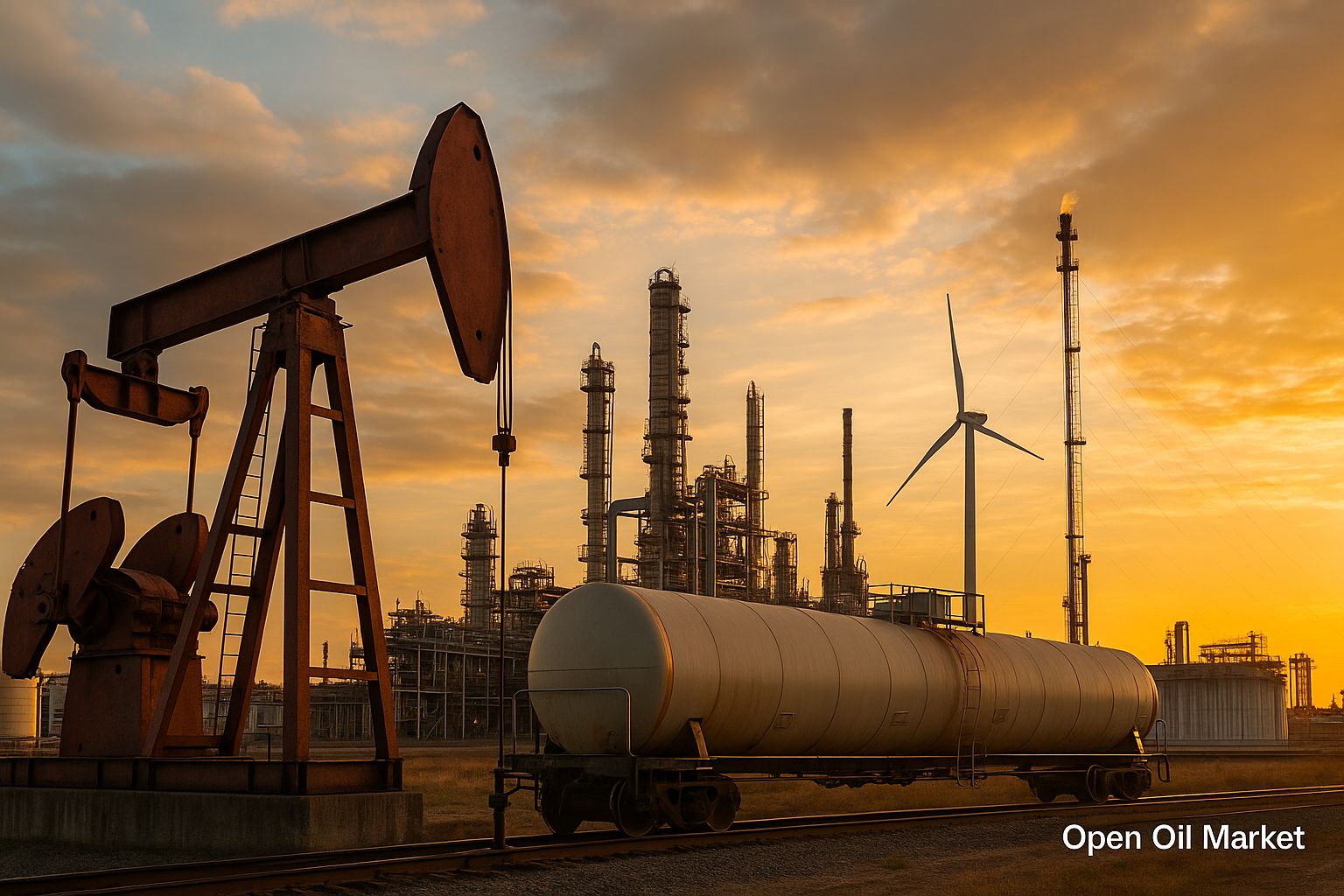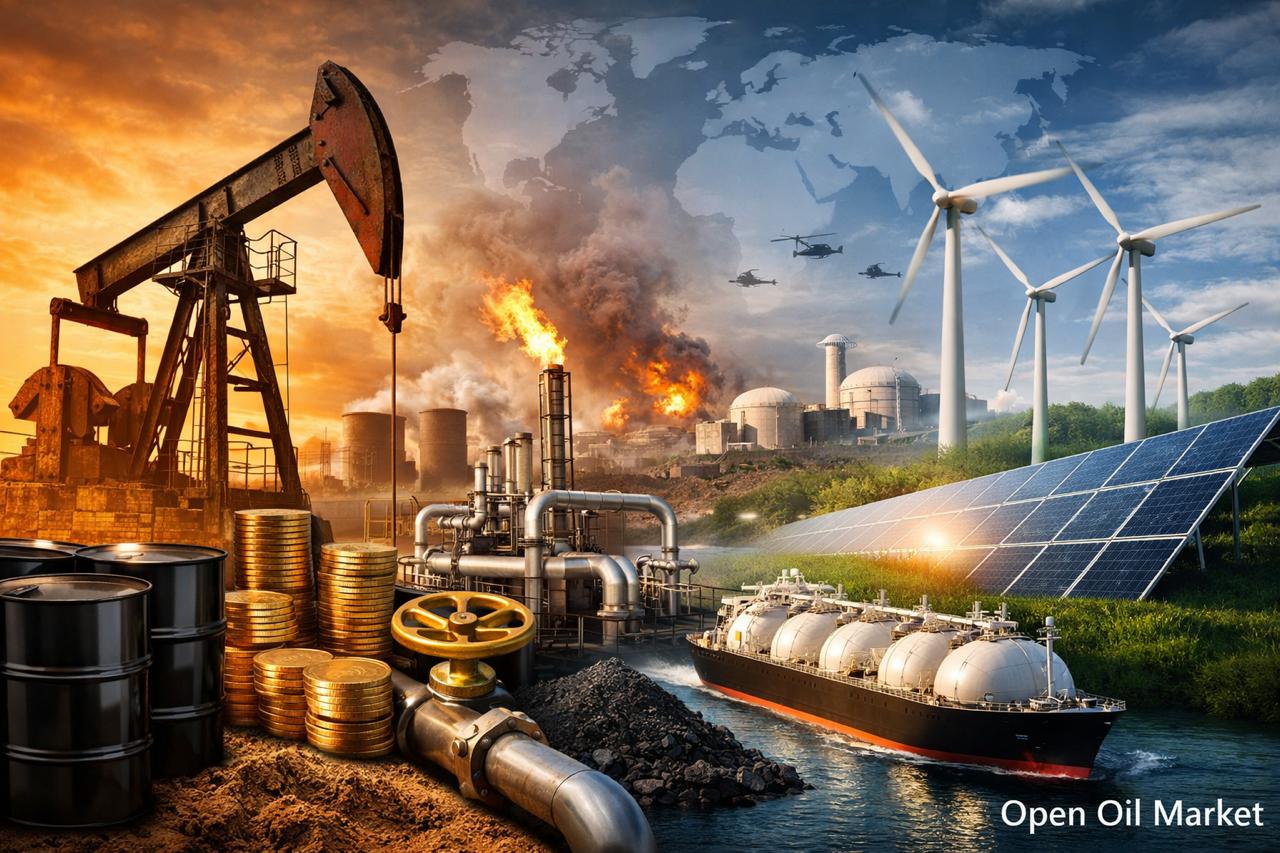
Global Energy Sector News as of October 15, 2025: Stabilization of the Fuel Market in Russia, Pressure on Oil Prices, Record Gas Reserves, Record Investments in Renewable Energy and the Opening of Russian Energy Week. Analysis from Open Oil Market.
In mid-October, the global commodity markets are relatively stable despite a complex array of mixed factors. Oil prices remain under pressure due to expectations of oversupply by the end of the year, while the European gas market is entering winter with record reserves, providing a safety net. Simultaneously, a key industry forum, Russian Energy Week, has kicked off in Moscow, focusing on strategic issues within the fuel and energy sector. Western sanctions against the Russian energy sector continue to create tension, but the industry is adapting to the new conditions. Below is a review of the latest developments in the fuel and energy sector that are significant for investors, market participants, and oil and gas companies.
Stabilization of the Fuel Market in Russia: Government Measures and Initial Results
Following the acute fuel crisis in September, the situation in the domestic oil products market is gradually normalizing. The deficit of gasoline has been eliminated in most regions of Russia, wholesale prices have retreated from peak levels, and independent gas stations have resumed uninterrupted fuel sales. However, in areas distant from major refineries, supply tensions remain, and authorities continue to manage the situation by extending restrictions and implementing new market support mechanisms.
- Emergency Measures and Imports: The government has extended the ban on the export of automotive gasoline until December 31, 2025, and maintained restrictions on diesel fuel exports for independent suppliers until the end of the year. These actions aim to saturate the domestic market as much as possible. Simultaneously, discussions are ongoing about attracting resources from abroad, including the potential temporary elimination of import duties to facilitate the import of gasoline and diesel (e.g., from Belarusian refineries) to meet the needs of remote regions.
- Price Control and Dampening Measures: Starting October 1, a moratorium on the zeroing of the fuel damper was introduced—the government continues to compensate refineries for supplies to the domestic market, even if internal wholesale prices exceed threshold levels. This measure preserves the economic motivation to direct gasoline and diesel to domestic gas stations. Simultaneously, the Federal Antimonopoly Service (FAS) and the Ministry of Energy have intensified price monitoring: several gas station chains have received warnings for unjustified fuel price increases. Some market participants propose establishing official retail price limits at gas stations; however, the government is currently avoiding direct regulation, relying on market mechanisms and targeted support measures instead.
- Initial Results: By mid-October, the deficit of motor fuel has significantly decreased. The completion of unscheduled repairs at refineries and the redirection of export volumes to the domestic market have allowed for an increase in wholesale shipments to affected regions. In central and southern areas, gasoline and diesel reserves at depots and gas stations are returning to normal levels. The government hopes to navigate the winter period without acute supply disruptions, although the situation requires constant monitoring and readiness for additional interventions.
Commentary. The government's actions to stabilize the market were timely and necessary, notes Sergey Tereshkin, CEO of the fuel products marketplace Open Oil Market. According to him, maintaining damper payments at high prices and limiting exports helped saturate the domestic market and alleviate the crisis. Moving forward, in addition to manual regulation, the sector requires systemic development of infrastructure, including the implementation of digital platforms for wholesale oil product trading, to enhance transparency in fuel distribution across regions and prevent similar situations from occurring in the future.
Oil Market: Oversupply, Price Risks, and Sanction Factors
The global oil market in the second decade of October displays a moderately downward price trend. The Brent grade has stabilized in the range of $62–64 per barrel, while American WTI crude is trading at $58–60. This is significantly below the year's peaks (around $80) and reflects expectations of an oversupply by the end of 2025. OPEC+ countries are following through on their decision to gradually increase production: starting in November, the overall quota will increase by approximately 137,000 barrels per day, continuing the policy of slowly regaining market shares. At the same time, demand is growing weaker than predicted, adding to the pressure on prices.
- Demand Slowdown: The International Energy Agency (IEA) has reduced its forecast for global oil demand growth in 2025 to approximately 710,000 barrels per day (previously expected at 740,000). This is significantly lower than in previous years, amid economic slowdowns in Europe and China. OPEC also predicts modest demand growth (around 1.2 million b/d), while production outside OPEC (primarily from the U.S.) is increasing at a faster pace. As a result, analysts warn of the likelihood of oil oversupply in the global market in the fourth quarter, which keeps prices under pressure.
- Sanctions and Geopolitics: Sanction pressure remains a significant factor for the oil sector. Mid-year saw the implementation of a new price cap on Russian oil set at $47.6 per barrel (the 18th EU sanctions package), and Western countries are discussing further restrictions on energy exports from Russia. Washington is urging allies to work towards a complete ban on Russian oil and to curb sanction circumvention through a "shadow fleet" of tankers. These efforts pose risks for global oil trade: any tightening of sanctions could restrict availabilities and trigger another wave of price volatility, especially if combined with other risk factors.
- New Markets: Despite sanctions, Russia has maintained significant volumes of oil exports by redirecting supplies from Europe to Asia. India and China have increased their purchases of Russian oil at discounted prices—traders estimate that up to 30% of India's oil imports come from Russian barrels. Deliveries to Turkey, the Middle East, and Africa are also increasing. This reorientation supports the revenues of the Russian energy sector and balances the global market, although it requires significant discounts and complicates logistics. Should sanctions further intensify (for example, through secondary measures against carriers or buyers), this channel may tighten, presenting a new challenge for Russian oil companies.
Natural Gas: European Reserves, the Rejection of Russian Gas, and the Eastern Pivot
The global natural gas market situation in October is favorable for consumers. The European Union is entering the heating season with record reserves: underground gas storage facilities (UGS) in EU countries are filled to over 95% of maximum capacity—significantly higher than last autumn’s level. Thanks to mild weather and an increase in liquefied natural gas (LNG) imports, Europe has established a safety cushion for a potential cold winter. Wholesale gas prices at the TTF hub remain relatively low (around €30–35/MWh), significantly below the peaks of 2022. The market remains stable, as demand this autumn has been moderate so far.
- Complete Rejection of Russian Gas: European countries continue their course towards a rapid reduction in dependence on Russian gas. Direct pipeline supplies from Russia have decreased to minimal volumes, maintained only among certain countries (e.g., Hungary) under historical contracts. The European Commission is preparing the 19th sanctions package, proposing to legally formalize a phased rejection of Russian LNG by 2026–2027. Already, the share of Russian gas in EU imports has declined from around 40% to less than 15% over the past two years, and it is expected that purchases from Russia will be reduced to zero in the coming years.
- Redirection of Supplies to the East: In response to the loss of the European market, Russia is increasing gas exports towards Asia. Supplies via the Power of Siberia pipeline to China are expected to reach record levels by 2025—over 22 billion cubic meters per year—approaching design capacity. Additionally, discussions are ongoing regarding the construction of a second mainline to China through Mongolia ("Power of Siberia 2"), which will partially compensate for the loss of European supplies by the end of the decade. Furthermore, Russia is expanding LNG sales to Asia: new projects in Yamal and the Far East are boosting liquefied gas supplies for India, China, Bangladesh, and other countries. Despite these steps, overall exports of Russian gas in the short term will remain below pre-sanction levels, with a priority on meeting domestic market demands and those of CIS partners.
Electricity Generation: Record Consumption and Network Modernization
Global electricity consumption continues to hit historical highs in 2025. Economic growth, the development of digital technologies, and the electrification of transport are driving increased electricity demand across all regions. Industry forecasts indicate that total global electricity generation is set to exceed 30,000 TWh for the first time this year—a record level. The largest contributions are expected from major economies: the U.S. is projected to consume about 4.1 trillion kWh (a new record for the country), while China is expected to exceed 8.5 trillion kWh. Electricity consumption is also rapidly rising in developing countries in Asia, Africa, and the Middle East, fueled by industrialization and population growth.
- Network Strain: The rapid growth in electricity consumption requires preemptive modernization of energy infrastructure. Many countries have announced large investment programs to expand and upgrade networks and construct new generation capacities. The goal is to prevent energy shortages and disruptions during peak loads. For instance, in the U.S., companies are investing billions of dollars to strengthen distribution networks amid increased loads from data centers and electric vehicle charging stations. Similar projects aimed at enhancing energy systems are being implemented in Europe, China, and India. Additionally, the role of intelligent "smart" grids and energy storage systems is increasing, helping to flexibly manage loads and integrate growing renewable generation.
Renewable Energy: Record Investments, Support, and New Challenges
The renewable energy sector (RES) is exhibiting impressive growth in 2025, continuing the global trend towards a "green" transformation of the energy sector. Investments in solar and wind energy, as well as related clean technologies, are setting records. In the first six months of 2025 alone, about $400 billion was invested globally in RES projects—10–12% more than in the same period last year. These funds are primarily directed towards the construction of new solar and wind power plants, as well as the creation of energy storage infrastructure (industrial batteries) and the digitalization of networks to facilitate distributed generation integration. With the introduction of new capacities, electricity generation is rising without an increase in greenhouse gas emissions.
Statistics confirm the progress: analysts estimate that approximately 380 GW of solar power plants have been commissioned globally in the first half of 2025—almost 1.7 times more than the previous year. Significant contributions to this growth have come from megaprojects in China, India, the Middle East, and the U.S. Wind power capacities are also on the rise: new offshore wind farms are becoming operational in the North Sea (EU), off the coast of China, and Southeast Asia, adding tens of gigawatts to the global energy balance.
- Share of Clean Energy: Renewable sources are taking on an increasingly significant role in the global energy balance. Currently, about 30% of global electricity generation is provided by RES. In the EU, this figure has exceeded 45%, driven by active climate policies and the closure of coal-fired power plants. China is nearing the 30% mark for generation from RES, despite the immense scale of its energy system and the continued construction of new coal power stations. For the first time in 2025, global electricity generation from solar and wind has surpassed coal generation—an important symbolic milestone for the energy sector.
- Government Support and Initiatives: The governments of major economies are ramping up support for "green" energy. In Europe, new climate targets have been adopted, requiring an accelerated introduction of clean capacities and the development of carbon trading. In the U.S., measures to promote RES and related industries continue (tax incentives and subsidies under the Inflation Reduction Act, IRA). CIS countries are also launching initiatives: Russia and Kazakhstan are conducting auctions for the selection of solar and wind projects, and Uzbekistan is building large solar parks in desert regions. Such support aims to reduce industry costs and attract new investments, accelerating the transition to clean energy.
- Growth Difficulties: The rapid development of RES is accompanied by challenges. High demand for equipment and raw materials (for instance, polysilicon for solar panels) leads to rising project costs and pressure on supply chains. The industry is also experiencing a shortage of skilled personnel necessary for the construction and operation of hundreds of new facilities around the world. Furthermore, energy systems are facing the need to maintain flexibility: integrating a large volume of variable generation requires accelerated development of energy storage systems and intelligent load management. Despite these challenges, the global course on decarbonization remains firm—experts predict continued growth in investments in RES and the achievement of new records in the share of clean energy.
Coal Market: Asian Demand and Gradual Coal Phase-Out
The global coal market in 2025 is characterized by mixed trends. In several Asian countries, demand for coal remains high, at times even increasing. In the summer, there was a surge in imports of thermal coal in East Asia: in August, China, Japan, and South Korea collectively increased purchases by nearly 20% compared to the previous month. Domestic factors have played a role: in China, enhanced environmental inspections and safety requirements temporarily reduced coal production, while industrial energy consumption was rapidly increasing. China compensated for the missing generation by ramping up coal imports, driving regional prices up: Australian Newcastle coal prices rose above $110 per ton (the highest in the last five months). Similarly, India and other developing economies increased coal burning to maintain the stability of their energy systems.
However, the long-term outlook for the coal sector remains unfavorable. More and more countries are adhering to policies to phase out coal for environmental goals and emission reductions. The share of coal generation in the EU has fallen below 10% (previously around 15%), and 11 EU countries plan to completely close all coal-fired power plants by 2030, replacing them with gas and renewable capacities. In the U.S., despite isolated initiatives to support coal producers, market conditions are also unfavorable for coal: cheap natural gas and the rapid expansion of RES are displacing coal from the energy mix. Even countries traditionally reliant on coal are reducing its use—Germany, for example, after a temporary increase in coal burning in 2022–2023, has curtailed electricity production at coal-fired plants again in 2025.
- Redirection of Exports from Russia: For Russia, one of the largest coal exporters, global trends mean a shift in primary markets. Following the EU embargo imposed in 2022, Russian coal companies redirected their supplies to Asia. Currently, more than 75% of Russia's coal exports go to China, India, Turkey, and other Asia-Pacific countries. This demand partially compensates for the loss of the European market, although sales to distant countries require discounts and increase logistics costs. In the long term, as leading global economies increasingly phase out coal, Russian coal producers will have to adapt—develop new markets and improve efficiency to remain competitive.
Forecasts and Expectations: The Forum in Moscow and the Winter Season
The onset of the fourth quarter of 2025 sets mixed expectations for the industry. On one side, the measures taken to stabilize the market instill cautious optimism: the Russian fuel market is emerging from the crisis thanks to government actions, and global oil and gas prices are being kept in check by OPEC+ efforts and record reserves. On the other hand, the upcoming winter season and the persistence of geopolitical tensions are factors that could provoke new fluctuations in the markets. Unpredictable weather conditions or abrupt tightening of sanctions may once again disrupt the balance of supply and demand.
Russian Energy Week, which opened on October 15 in Moscow under the motto "Creating the Energy of the Future Together," has become a platform for discussing these challenges and prospects. New agreements and partnerships aimed at the development of the fuel and energy complex and the strengthening of international cooperation are expected to emerge from the forum. The outcomes of the meeting of industry leaders will set the tone for further reforms and investments. Overall, investors and market participants in the energy sector are closing the year with a sense of cautious optimism—the adaptation to new conditions continues, and the energy sector demonstrates resilience and readiness for change.




